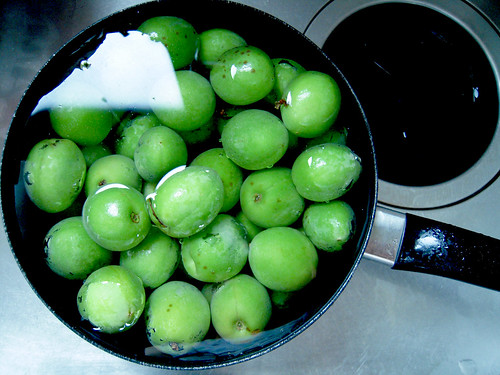
Japanese mothers and grandmothers are hardcore. Every year they make their own liqueur and June is the month to start preparing. Starting in late May, supermarkets stock ume (Japanese plums) in bags of 1 kilogram which cost around 700-900 yen per bag, alongside cartons of white liquor. I decided to join the mama-san frenzy and make my own
umeshu this year.
Ingredients
1 kg ume
1 kg rock sugar (koori-zato), you can also substitute this with honey
1800 milliliters of white liquor, you can also substitute this with vodka or brandy
Large jar with tight lid
Bamboo skewer
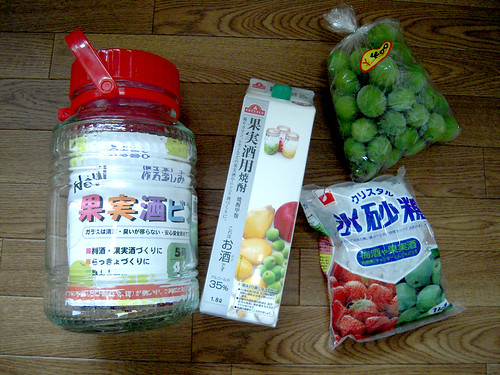 Directions
Directions
1. Soak ume in water for 2-4 hours so that you get all the dirt off the surface of the ume.
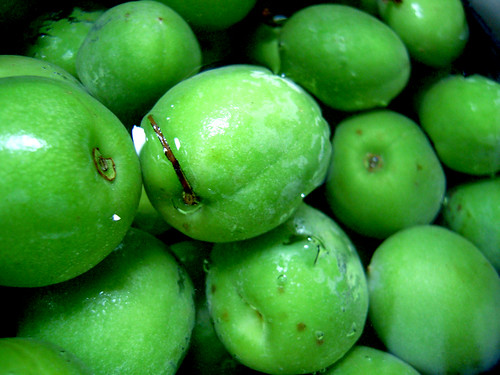

2. With a bamboo skewer, remove the stems.
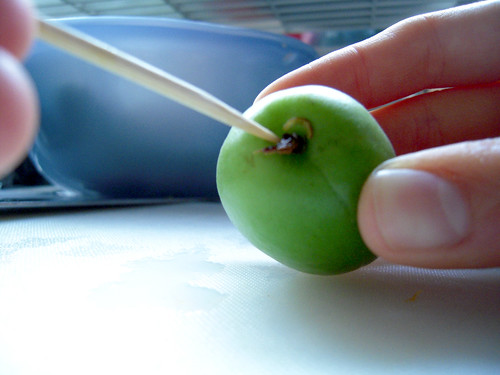
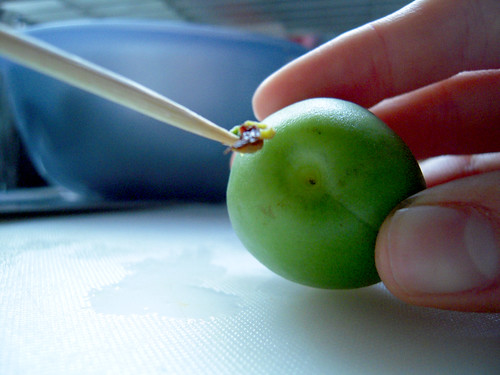
3. You are now ready to add the contents into the jar. Add a layer of rock sugar, then a layer of ume. Repeat until you run out of the sugar and ume.
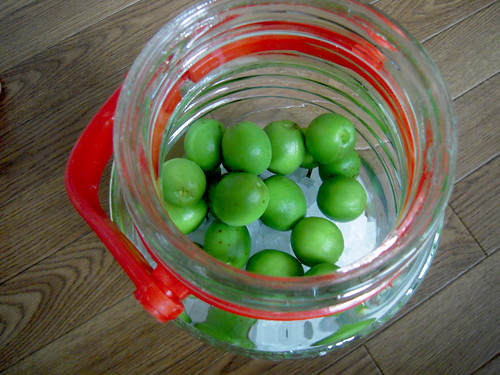
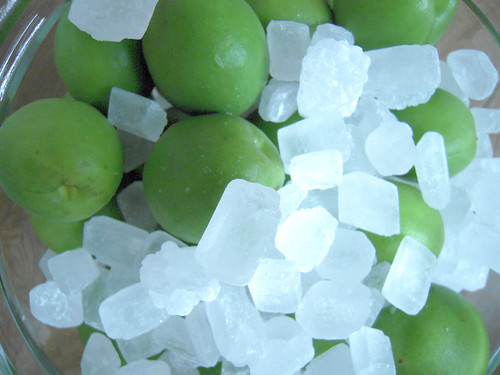
4. Add all 1800 milliliters of the liquor to the jar.
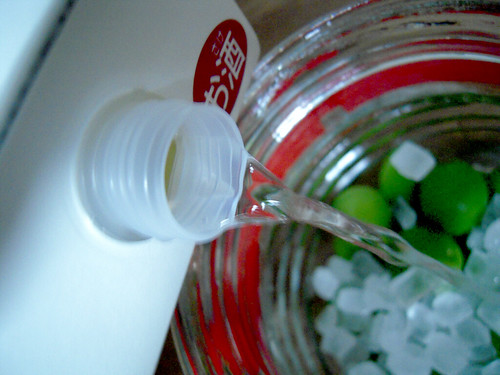
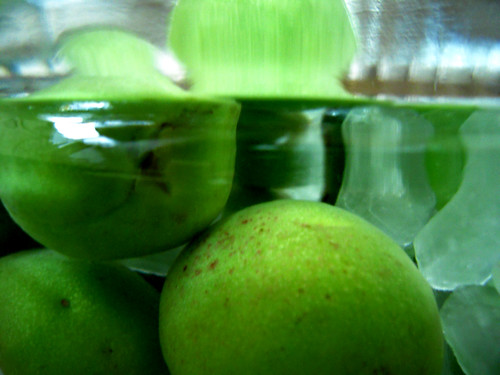
5. Seal the jar tightly and keep in a cool, dry place for 3-4 months.
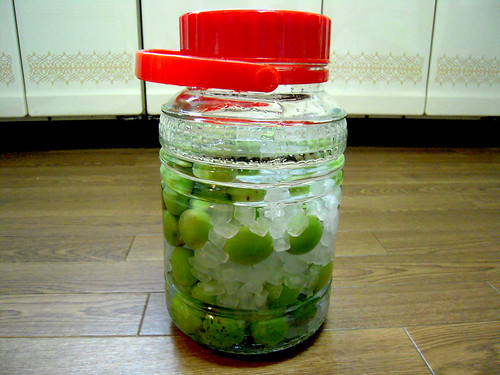
This is the jar after only two days. The ume have floated to the top and the sugar sunk to the bottom. Notice that the beautiful green color of the ume is already yellowish.
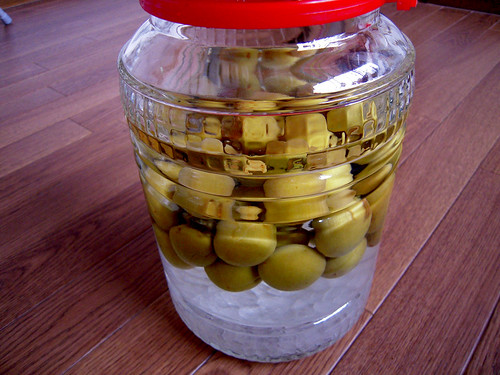
Now, I'm gonna sit here and wait until October.
*Yoko lives in Tokyo. She loves dips, dashi and deals.
 Japanese mothers and grandmothers are hardcore. Every year they make their own liqueur and June is the month to start preparing. Starting in late May, supermarkets stock ume (Japanese plums) in bags of 1 kilogram which cost around 700-900 yen per bag, alongside cartons of white liquor. I decided to join the mama-san frenzy and make my own umeshu this year.
Ingredients
1 kg ume
1 kg rock sugar (koori-zato), you can also substitute this with honey
1800 milliliters of white liquor, you can also substitute this with vodka or brandy
Large jar with tight lid
Bamboo skewer
Japanese mothers and grandmothers are hardcore. Every year they make their own liqueur and June is the month to start preparing. Starting in late May, supermarkets stock ume (Japanese plums) in bags of 1 kilogram which cost around 700-900 yen per bag, alongside cartons of white liquor. I decided to join the mama-san frenzy and make my own umeshu this year.
Ingredients
1 kg ume
1 kg rock sugar (koori-zato), you can also substitute this with honey
1800 milliliters of white liquor, you can also substitute this with vodka or brandy
Large jar with tight lid
Bamboo skewer
 Directions
1. Soak ume in water for 2-4 hours so that you get all the dirt off the surface of the ume.
Directions
1. Soak ume in water for 2-4 hours so that you get all the dirt off the surface of the ume.

 2. With a bamboo skewer, remove the stems.
2. With a bamboo skewer, remove the stems.

 3. You are now ready to add the contents into the jar. Add a layer of rock sugar, then a layer of ume. Repeat until you run out of the sugar and ume.
3. You are now ready to add the contents into the jar. Add a layer of rock sugar, then a layer of ume. Repeat until you run out of the sugar and ume.

 4. Add all 1800 milliliters of the liquor to the jar.
4. Add all 1800 milliliters of the liquor to the jar.

 5. Seal the jar tightly and keep in a cool, dry place for 3-4 months.
5. Seal the jar tightly and keep in a cool, dry place for 3-4 months.
 This is the jar after only two days. The ume have floated to the top and the sugar sunk to the bottom. Notice that the beautiful green color of the ume is already yellowish.
This is the jar after only two days. The ume have floated to the top and the sugar sunk to the bottom. Notice that the beautiful green color of the ume is already yellowish.
 Now, I'm gonna sit here and wait until October.
*Yoko lives in Tokyo. She loves dips, dashi and deals.
Now, I'm gonna sit here and wait until October.
*Yoko lives in Tokyo. She loves dips, dashi and deals.




Comments (11)
Wow, sugoi!
I guess my visit in October is perfect timing to sample your first moonshine!
Mitsuwa in NJ had exact the same ingredients when I went there a couple of weeks ago. It was very tempting. I wonder if I can make liquor with something else using pre ripen fruits we can get here..
Oooooh, I want to try this! Yama, did they have the ume too, or just the booze and sugar?
Anders – Definitely, it's going to be SO ready when you get here.
Yamahomo – Yes, I think you can substitue ume for pretty much anything. I've seen several recipes that use all kind of fruits and vegetables. Check out this site (it's in Japanese)
http://www.shochu.or.jp/kajitsushu/homemade/index.html
But it lists all kind of recipes, including tomato, avocado and coffee liquor!
OMG, there are SOOOOO many options. I still have to go to Mitsuwa to get white liquor… I am going to try some soon.
What exactly is "white liqour"? It's not sake
Where do you buy the ume, rock sugar and the white liquor? Is it still okay to start it now even though it is mid June?
White liquor, includes vodka and shochu. I am not really sure how the ones sold in cartons in Japanese markets differ from generic shochu. White liquor is 35% alcohol, so I suppose that to make umeshu, that is the one of most important qualities of the alcohol that is used. That being said, my friend is making his umeshu with brandy, which is not considered a white liquor.
I think you can buy ume, rock sugar and white liquor at Mitsuwa, or Japanese markets in America. It is okay to start even in mid June, as long as you can find the ingredients. My grandma living in California knew someone who had an ume tree in their garden. She would hord this woman's ume (the woman was not Japanese), who was more than happy to give the fruits to my grandma. If you happen to come across one in someone's yard, it would be worth asking them if you can pick some, because it's really under appreciated in the states.
yesterday i’ve bought that from japan,.. and i try last night.. that so delicious i love it.. why its called SAKE? but not alcohol?
aRie
Umeshu does contain alcohol. Some types of umeshu are made with sake but usually, it’s made with shochu or white liquor.